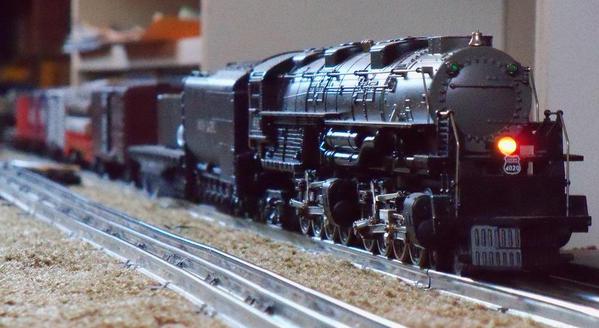Originally Posted by OGR Webmaster:
... Can you imagine the results if the front engine had 63" drivers and the rear engine was at 63 1/2"? Or vice versa? How many miles do you think it would take before they were all the same diameter again?
I tracked down some information about different size drivers on duplex-drive locomotives, in the Kalmbach book "Guide to North American Steam Locomotives", page 324:
"In the mid 1920's [regarding larger locomotives] ... Alco pushed three-cylinder locomotives, and Lima developed the Super-Power concept ... Baldwin ... began advocating duplex, or divided, drive."
"The duplex drive represented an engineering compromise. Main and side rods could be lighter ... easier to counterbalance ... the worst problem was the independence of the two sets of running gear. When they were in phase (running in unison), they created a surging, fore-and-aft motion in the train. Minor variations in adhesion, caused by something as trivial as the locomotive entering a curve, caused one unit to slip, throwing the load on the other, then regain adhesion - among the results were rough handling of the train and radical changes in draft that lifted the fire off the grates ..."
"Baltimore & Ohio built its own [4-4-4-4] duplex-drive locomotive, #5600, in 1937. Both sets of cylinders were the same size, 18" x 26", and the rear cylinders were mounted backwards, under the outer edge of the firebox and ahead of the trailing truck. During testing B&O found that the two sets of drivers gradually got in step with each other - ideally they should be 45° out of phase - so the road turned the tires of one set down from 76" to 75", which, assuming no slipping, made the two sets of drivers go in and out of phase with each other three or four five times a mile ... It was taken out of service in 1943 and scrapped in 1950."
I'm wondering if this "surging" phenomena was noticed on articulated locos if the drivers happened to all get in synch. Perhaps it was more of an issue on the duplex-drive units because of taller drivers, faster speeds, higher steam pressures, shorter cutoffs, different valve gear, adhesion problems, multiple factors?
Why they didn't add inside cranks and rods to connect the two sets of drivers on a rigid-frame duplex to maintain eight evenly spaced power strokes per drive wheel revolution, and gain significantly improved traction? The inside rods could have been offset from the outside rods to minimize the need for counterbalancing. But that would have increased the mechanical complexity, and the maintenance of inside motion tended to be neglected.
My O-gauge Big Boy drivers go in and out of synch periodically Something has to slip, going around the curves. . Makes it more interesting, I think.





